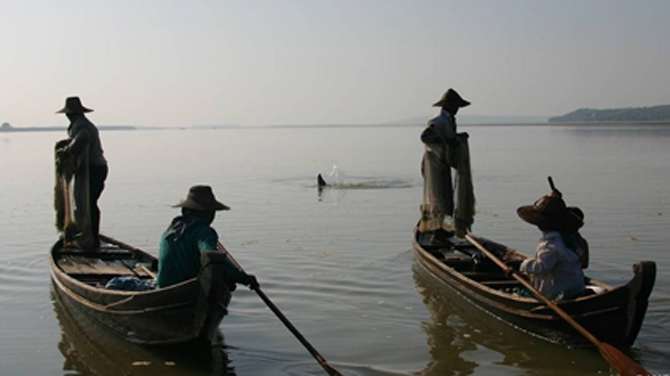However, the species remains critically endangered due to electro-fishing and mercury poisoning—the latter due to waste products of gold mining and dredging of the upper regions of the river.
“As numbers increase and even babies are found, there is much hope that we can maintain the population. We still need the cooperation of the locals, fishermen and, of course, the gold miners,” said Than Myint, national director of WCS in Rangoon.
Measures to protect Irrawaddy dolphins include the prohibition of using mercury in gold mining dredging, catching or killing of dolphins, or trading in their meat. It is also forbidden to electro-fish or use gillnets more than 300 ft (91m) long, or spaced less than 600 ft (180m) apart, and there is the mandatory release of entangled dolphins.
“Gold mining or fishing is the business of someone else so we cannot obstruct them,” said he. “As we help to educate people and prevent some actions that may harm these adorable creatures, they also have to be aware that this endangered species is precious and a source of pride for our country. I believe people will help preserve them in the near future.”
As tourism in Burma starts to boom this year, packages to watch Irrawaddy dolphins will surely increase. A tour operator from Rangoon told The Irrawaddy that he has received several queries for the year ahead and demand has doubled compared to the previous season, even though he could not guarantee sightings.
“To watch Irrawaddy dolphins, one has to be very patient and sometimes it takes a day or two,” said the tour guide. “Even for the fishermen, there are times the dolphins do not respond to their signals and they have to fish without them.”
Tint Tun, a marine biologist who researches Irrawaddy dolphins, has urged the Burmese authorities to adopt suitable awareness protocols in order to prevent unnecessarily disturbing the creatures, especially as tourist numbers traveling along the Irrawaddy River increase.
“Although our Irrawaddy dolphins do not have much contact with travelers like in other countries, it is necessary to know which way of approaching might disturb or frighten them,” said Tint Tun. He recalled an excursion to Cambodia—where Irrawaddy dolphins are one of the main attractions for tourists—with tours forbidden from using boats with engines but only paddle canoes to approach dolphins.
“We cannot work alone to protect them. More research on these amazing creatures is still needed to better protect them,” added Tint Tun. “Due to the lack of access to high-tech equipment, it is a bit difficult to trace them as they swim all along the river. Collaborations between every concerned person would be heartily welcomed.”

